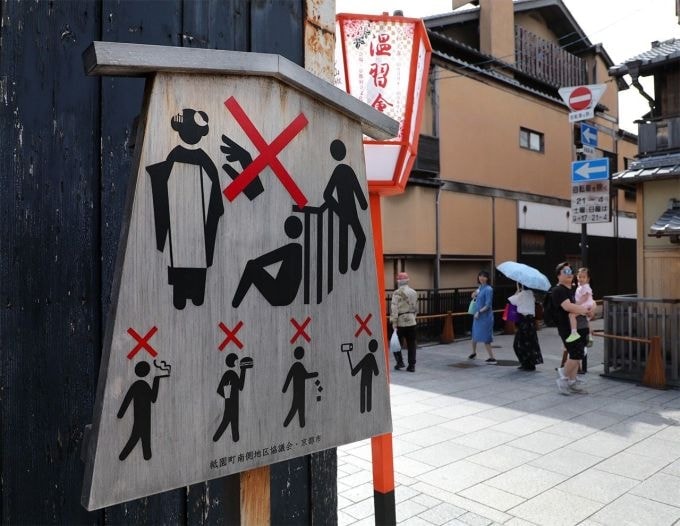Tourism provides significant support to Japan's aging, declining economy, but it needs to avoid the current "passive storm of visitors," experts say.

Images of the Blue Lagoon and black sand beaches of Iceland once dominated social media. Now they’re replaced by colorful photos of Mount Fuji and videos of snow monkeys bathing in the hot springs of Japan’s Jigokudani National Park.
“Japan has become a must-go destination, especially for younger travelers,” says Katherine Flynn, a travel planner at New York-based Fora, adding that it’s one of the few destinations where travelers will include a TikTok link when filling out their “must-do” activities form.
In 2024, the number of tourists visiting Japan will hit a record high of nearly 37 million, up 47% from 2023 and up 15% from 2019. The number of Americans visiting Japan in December alone increased more than 30% year-on-year, according to preliminary data from the Japanese government.
The surge in travel is partly due to a weaker yen, which has made Japan, once considered an expensive destination, more affordable. Lauren Joory, another consultant at Fora, said the strength of the dollar against the yen, combined with Japan’s closure of its borders for several years after the pandemic, has made American travelers more eager to visit the country.
Similarly, Iceland’s tourism boom came after an economic crisis and even helped the country recover from it. While tourists can bring economic growth, they can also bring serious problems related to overtourism – something that some areas in Japan are currently facing.
Following the 2008 financial crisis, the Icelandic krona plummeted, causing the country’s stock market to collapse. Thousands lost their homes and unemployment skyrocketed. Two years later, the Eyjafjallajokull volcano erupted, disrupting air travel in Europe, further exacerbating Iceland’s predicament. However, the country has also begun to gain attention from global tourists.
Tourists, lured by the weak krona and creative marketing campaigns by low-cost airlines, have flocked to Iceland. The number of annual visitors to Iceland increased by 328% between 2010 and 2019.
“Tourism has been incredibly important in helping Iceland recover from the crisis and has become the country’s biggest export,” said Sigriour Dogg Guomundsdottir, then head of Visit Iceland, in 2022.
Now, Japan is facing its own economic challenges, including a weak yen, high inflation and falling GDP. The country is also struggling with an aging population, low birth rates and a labor shortage.
“Tourism is a quick fix for many struggling countries,” said Alan Fyall, professor of tourism marketing at the University of Central Florida. The impact of tourism is powerful, but countries need to know how to manage it.
In 2019, travel news siteSkiftcalls Iceland “a model for both the positive and negative impacts of overtourism.” The rapid growth of tourism has led to overcrowding in hotspots; poor tourist behavior; pressure on infrastructure and natural resources; high prices for both locals and visitors; and overreliance on tourism.

Japan is much larger than Iceland in terms of land area, population and GDP, but it is facing similar problems. Masaru Takayama, chairman of the Japan Alliance of Responsible Travel Agencies, said Kyoto, where he lives, had become the “capital of overtourism”. Senior citizens there can take free buses and subways, but now they can’t even get seats.
Local businesses have also adapted to cater to tourists. His favorite restaurants near his home are now hard to get a table at because of long lines of tourists who have reserved reservations for months. Prices have gone up, and menus have changed to suit foreign tastes.
“We can still see those locations but we can't get in,” he said.
Short-term rentals also push up rents and property taxes, affecting people who do not work in the tourism industry.
Japan has taken some steps to control tourism. Last year, Kyoto banned tourists from some alleys in the Gion geisha district after complaints of disrespectful behavior. Fujikawaguchiko, a town near Mount Fuji, erected barricades to keep tourists away from a popular photo spot after complaints from local residents. Japan has also introduced new regulations and a tourist tax for climbing Mount Fuji to reduce overcrowding.
However, experts say Japan should take a proactive approach rather than a passive response to the problem of overtourism.
Iceland, in the wake of the pandemic, has shifted to a sustainable tourism strategy by introducing a tourist tax, investing in infrastructure, building parking lots, toilets, walking paths and encouraging visitors to explore less popular areas.
Experts say Japan could do the same, suggesting it could adopt awareness campaigns for tourists, such as the Palau Pledge, a commitment to protect the environment and culture that tourists must sign when visiting Palau. Or take a page from Thailand, which has been aggressively promoting less crowded destinations like Chiang Mai instead of focusing on Bangkok or Phuket.
TH (according to VnExpress)